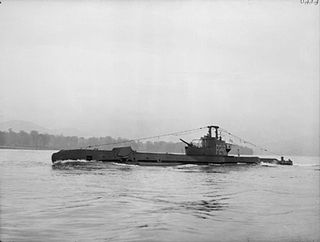
The Amphion class of British diesel-electric submarines were designed for use in the Pacific War. Only two were completed before the end of hostilities, but following modernisation in the 1950s, they continued to serve in the Royal Navy into the 1970s.
Seven vessels of the British Royal Navy have borne the name HMS Amphion, after the Greek hero Amphion.

HMS Trump was a British submarine of the third group of the T class. She was built by Vickers Armstrong, Barrow, and launched on 25 March 1944. So far she has been the only ship of the Royal Navy (RN) to bear the name Trump. She spent the majority of her life attached to the 4th Submarine Squadron based in Australia. She was kept in service following the war and was refitted for greater underwater performance, and was the final RN submarine to be posted in Australia, departing in January 1969. She was sold off and broken up for scrap in August 1971.
HMS Seraph was an S-class submarine built for the Royal Navy during the Second World War. Completed in 1942, she carried out multiple intelligence and special operations activities during World War II, the most notable of which was Operation Mincemeat.

HMS Affray, a British Amphion-class submarine, was the last Royal Navy submarine to be lost at sea, on 16 April 1951, with the loss of 75 lives.

The Royal Navy Submarine Museum at Gosport is a maritime museum tracing the international history of submarine development from the age of Alexander the Great to the present day, and particularly the history of the Royal Navy Submarine Service from the navy's first submarine, Holland 1, to the nuclear-powered Vanguard-class submarines. The museum is located close to the former shore establishment HMS Dolphin, the home of the Royal Navy Submarine Service from 1904 until 1999.

Holland 1 is the first submarine commissioned by the Royal Navy. The first in a six-boat batch of the Holland-class submarine, she was lost in 1913 while under tow to be scrapped following her decommissioning. Recovered in 1982, she was put on display at the Royal Navy Submarine Museum, Gosport. Her battery bank found in the boat was discovered to be functional after being cleaned and recharged.
HMS Ambush (P418/S68/S18), was an Amphion-class submarine of the Royal Navy, built by Vickers Armstrong and launched 24 September 1945.

HMS Andrew (P423/S23/S63), was an Amphion-class submarine of the Royal Navy, built by Vickers Armstrong and launched on 6 April 1946.

HMS Amphion (P439), was an Amphion-class submarine of the Royal Navy, built by Vickers Armstrong and launched 31 August 1944.

HMS Artful (P456), was an Amphion-class submarine of the Royal Navy, built by Scotts Shipbuilding and Engineering Company of Greenock and launched 22 May 1944.
HMS Artemis (P449) was an Amphion-class submarine of the Royal Navy, built by Scotts Shipbuilding & Engineering Co. of Greenock and launched 28 August 1946. The submarine sank while refueling in 1971, was raised and sold for breaking up in 1972.

HMS Totem was a Group 3 T-class submarine of the Royal Navy which entered service in the last few months of World War II. To-date, she is the only ship of the Royal Navy to have been named Totem.

HMAS Otway was an Oberon-class submarine of the Royal Australian Navy (RAN). One of the first four Oberon-class boats ordered for the RAN, Otway was built in Scotland during the mid-1960s, and commissioned into naval service in 1968. The submarine was decommissioned in 1994. The submarine's upper casing, fin, and stern are preserved at Holbrook, New South Wales.

HMS Scotsman was a third-batch S-class submarine of the third batch built for the Royal Navy during World War II. After training exercises in Britain during which she ran aground, requiring repairs, she was transferred to the Pacific fleet as the war with Germany had ended. The submarine sank one junk en route to her submarine unit, but arrived after the end of the Pacific war and World War II. She was scrapped in November 1964.

HMS Storm was an S-class submarine of the Royal Navy, and part of the third group built of that class. She was built by Cammell Laird and launched on 18 May 1943. So far, she is the only RN ship to bear the name Storm.

HMS Triad was a T-class submarine of the Royal Navy. She was laid down by Vickers Armstrong, Barrow and launched in May 1939.

HMS Tabard was a British submarine of the third group of the T class. She was built by Scotts, Greenock, and launched on 21 November 1945. So far she has been the only boat of the Royal Navy to bear the name Tabard, after the item of clothing. Having been launched after the war, she was selected, along with a number of boats of her class, to try out new streamlining techniques based on the German Type XXIII submarine. In May 1963, she was involved in a collision with HMAS Queenborough, and on 10 February 1964 she underwent exercises with HMAS Melbourne and HMAS Voyager in the hours before their collision. When she returned to the UK, she became the static training submarine at the shore establishment HMS Dolphin, until 1974 when she was sold and broken up.

HMS Turpin was one a group three T-class submarines of the Royal Navy which entered service in the last few months of World War II. So far she has been the only ship of the Royal Navy to be named Turpin. She was sold to Israel in 1965 and commissioned into the Israeli Sea Corps in 1967 as INS Leviathan.

The QF 4-inch gun Mark XXIII was introduced in late 1945 as a deck gun for Royal Navy submarines. It was the last type of gun to be fitted to British submarines, finally being retired in 1974.

















